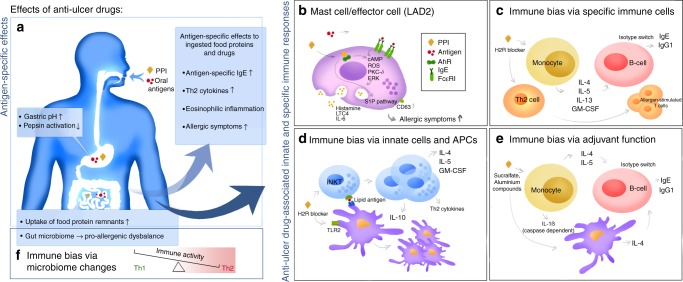Fig. 1.
Overview of direct and indirect pro-allergenic immune responses to anti-ulcer drugs (AUD). a, f With regards to oral allergens, the gastric pH elevation by AUDs, most dominantly by proton-pump inhibitors (PPI) and H2 receptor antagonists (H2RA), leads to reduced pepsin activation and impaired food antigen degradation, enabling persistence of ingested epitopes and their uptake in the intestines14–16,23,24. This leads to formation of antigen-specifc IgE and promotion of a Th2 type dominated immune milieu resulting in eosinophilic inflammation and allergic symptoms14,15,24. b–e With regards to directly AUD-associated innate and adjuvant immune effects, PPIs can (b) induce AhR-mediated mast cell activation synergizing with IgE-FcɛRI signaling and resulting in mediator release30 and enhanced CD63 expression via the S1P pathway; both mechanisms result in allergic symptoms manifestation; (c) H2RAs stimulate the release of Th2 cytokines from both monocyte and Th2 cells leading to a B-cell isotype switch resulting in IgG1 (mice) and IgE production (humans, mice)31; (d) Further, H2RAs promote an increase in Th2 cytokine releasing iNKT cells32, particularly when co-exposed to lipid antigens, and increase in CD1d+ DCs via TLR2 activation; (e) Sucralfate, an aluminum compound, can induce IL-4 release from DCs along with IL-533,34 and caspase-dependent IL-1β secretion43 from monocytes promoting an isotype switch in B-cells into IgE production; f The resulting disturbance of gut microbiota composition35,37,45 additionally supports a pro-allergic Th2 milieu and enhances allergic symptoms

